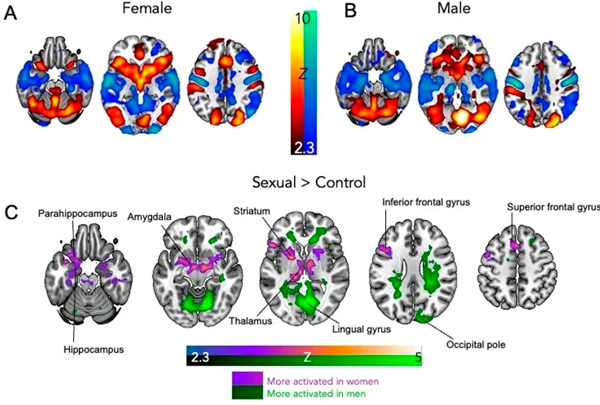Nye publikasjoner
Studie avslører forskjeller i hjernens respons på lav sexlyst hos menn og kvinner
Sist anmeldt: 02.07.2025

Alt iLive-innhold blir gjennomgått med medisin eller faktisk kontrollert for å sikre så mye faktuell nøyaktighet som mulig.
Vi har strenge retningslinjer for innkjøp og kun kobling til anerkjente medieområder, akademiske forskningsinstitusjoner og, når det er mulig, medisinsk peer-evaluerte studier. Merk at tallene i parenteser ([1], [2], etc.) er klikkbare koblinger til disse studiene.
Hvis du føler at noe av innholdet vårt er unøyaktig, utdatert eller ellers tvilsomt, velg det og trykk Ctrl + Enter.

I en fersk studie publisert i tidsskriftet Scientific Reports undersøkte forskere de nevrofunksjonelle determinantene for hypoaktiv seksuell lystforstyrrelse (HDSS) hos menn og kvinner. Enkelt sagt er det en tilstand der folk opplever en plagsom reduksjon i seksuell lyst. Lidelsen har blitt studert hos kvinner før, men aldri hos menn. I denne studien brukte forskerne funksjonell magnetisk resonansavbildning (fMRI) kombinert med psykometriske spørreskjemaer for å vurdere de nevrofunksjonelle responsene til menn og kvinner på seksuelle og ikke-seksuelle videopresentasjoner.
Denne studien fant at kvinner med hypoaktiv seksuell lyst følger en ovenfra-og-ned-teori, som antar at hyperaktivitet i høyere kognitive områder av hjernen undertrykker lavere nivåer av de seksuelle hjerneområdene. I motsetning til kvinner ble ikke dette nevrofunksjonelle mønsteret observert hos menn, noe som fremhever seksuell dimorfisme i hvordan mannlige og kvinnelige hjerner behandler seksuelle stimuli. Selv om forskerne ikke klarte å belyse de kognitive mekanismene som ligger til grunn for HDSS hos menn, fremhever denne studien behovet for mer forskning på HDSS hos menn og antyder at behandlinger for lav seksuell lyst som brukes hos kvinner, kanskje ikke gir de ønskede resultatene hos menn.
Hva er HDSS, og hva vet vi om tilstanden?
Diagnostic and Statistical Manual of Mental Disorders, Fourth Edition, Revised (DSM-IV-TR) definerer hypoaktiv seksuell lystforstyrrelse (HDSS) som «vedvarende seksuelle fantasier og lyst på seksuell aktivitet som forårsaker markert nød eller mellommenneskelige vanskeligheter». HDSS, populært omtalt som «nedsatt seksuell lyst», «hyposeksualitet» eller «hemmet seksuell lyst», er en seksuell dysfunksjon der symptomene inkluderer en betydelig mangel på seksuelle fantasier og opphisselse, selv hos seksuelt aktive menn og kvinner. Gitt den betydelige sosiale og mellommenneskelige nøden forårsaket av HDSS, er tilstanden ofte assosiert med depresjon og lignende emosjonelle lidelser.

Kvinner med HSDD viser større limbisk systemaktivering av seksuelle videoer enn menn.
(A) Gjennomsnittsresultater for en gruppe kvinner med HSDD som viser hjerneaktivering (rød/gul) og deaktivering (blå/grønn) av sexvideoer sammenlignet med kontrollgruppen (trening).
(B) Gjennomsnittsresultater for en gruppe menn med HSDD som viser hjerneaktivering og deaktivering av sexvideoer sammenlignet med kontrollgruppen (trening).
(C) Hjerneområder som er mer aktiverte hos kvinner (sammenlignet med menn) av sexvideoer sammenlignet med kontrollgruppen er vist i lilla. Hjerneområder som er mer aktiverte hos menn (sammenlignet med kvinner) av sexvideoer sammenlignet med kontrollgruppen er vist i grønt.
Resultatene er klyngekorrigerte og grenseverdiene er Z = 2,3, P < 0,05, N = 64 (32 kvinner, 32 menn).
Studie: Kvinner med HSDD viser større aktivering av det limbiske systemet til sexvideoer enn menn. (A) Gjennomsnittsresultater for den kvinnelige HSDD-gruppen som viser hjerneaktivering (rød/gul) og deaktivering (blå/grønn) til sexvideoer sammenlignet med kontrollgruppen (trening). (B) Gjennomsnittsresultater for den mannlige HSDD-gruppen som viser hjerneaktivering og deaktivering til sexvideoer sammenlignet med kontrollgruppen (trening). (C) Hjerneområder som er mer aktiverte hos kvinner (sammenlignet med menn) til sexvideoer sammenlignet med kontrollgruppen er vist i lilla. Hjerneområder som er mer aktiverte hos menn (sammenlignet med kvinner) til sexvideoer sammenlignet med kontrollgruppen er vist i grønt. Resultatene er klyngekorrigerte og terskelbestemte ved Z = 2,3, P < 0,05, N = 64 (32 kvinner, 32 menn). Studie: Kvinner og menn med plagsom lav seksuell lyst viser kjønnsforskjeller i hjerneprosessering.
HDSS ble først identifisert i 1980 (DSM-III) og formelt definert i 1987 (DSM-III-R), og er en klinisk forskjellig lidelse fra tilstander som aseksualitet og erektil dysfunksjon. Årsakene kan omfatte en historie med seksuelt misbruk, endrede kjønnshormonnivåer eller andre medisinske tilstander som kreft, diabetes og multippel sklerose. Til tross for den relativt nye beskrivelsen, er HDSS en av de vanligste seksuelle lidelsene over hele verden, anslått å ramme 10 % av alle kvinner og 8 % av alle menn. Gitt det sosiale stigmaet knyttet til tilstanden, anses disse tallene å være sterkt undervurdert, noe som understreker behovet for tiltak for å bekjempe virkningen av nevrofunksjonelle lidelser på livskvaliteten.
Dessverre, til tross for begrenset forskning på HDSS, fokuserer den tilgjengelige vitenskapelige litteraturen om emnet nesten utelukkende på kvinner, med den eneste tidligere studien på menn som bruker tvilsomme metoder. Denne ulikheten i forskning gjenspeiles i behandlingsalternativene, med to medisinsk godkjente intervensjoner for amerikanske kvinner og ingen for amerikanske menn. Et betydelig antall tilfeller av HDSS hos menn blir feildiagnostisert som erektil dysfunksjon, noe som forverrer stresset og den mentale helsen forbundet med tilstanden.
I denne studien hadde forskerne som mål å bruke funksjonell magnetisk resonansavbildning (fMRI) i kombinasjon med flere psykometriske spørreskjemaer for å vurdere de nevrofunksjonelle responsene til menn og kvinner med HDSS på seksuelle og ikke-seksuelle stimuli (i dette tilfellet videopresentasjoner – visuelle seksuelle stimuli). Studiedeltakerne var menn og kvinner med klinisk bekreftet HDSS (ICD-11) rekruttert gjennom annonser over hele London (trykte og nettbaserte medier). Screening av deltakerne besto av et telefonintervju etterfulgt av en personlig medisinsk vurdering (blodprøve og spørreskjemaer) for å skille ervervet fra generalisert HDSS. For å unngå forveksling med eksisterende kliniske tilstander ble personer med en historie med psykiatrisk sykdom eller som for tiden mottar behandling ekskludert fra studien.
«...deltakerne måtte være i et stabilt, kommunikativt, monogamt forhold i mer enn 6 måneder. Deltakerne ble ekskludert dersom de hadde en historie med uløste seksuelle traumer, misbruk eller aggresjon, bruk av medisiner (reseptbelagte eller reseptfrie) eller urtepreparater for å øke seksuell lyst, opphisselse eller ytelse, eller dersom de hadde kontraindikasjoner for MR-skanning.»
Den eksperimentelle intervensjonen involverte presentasjon av 20 sekunder lange stille seksuelle videoer (caser) ispedd nøytrale ikke-seksuelle treningsvideoer (kontroll) over en 12-minutters standardisert blokk (vurdert på en Likert-skala). Deltakerne måtte fullføre Sexual Desire and Arousal Inventory (SADI) rett før og etter den eksperimentelle intervensjonen, som målte 54 deskriptorer i kategoriene evaluerende, negativ, fysiologisk og motivasjonsmessig. Under den eksperimentelle intervensjonen gjennomgikk deltakerne samtidig fMRI og pulsoksymetri.
Databehandlingen inkluderte korrelasjoner mellom spørreskjemaresultater og fMRI-opphisselsesbilder, samsvar mellom aktiveringsmønstre hos menn og kvinner (via Dice-koeffisienter) med seksuelle og ikke-seksuelle visuelle stimuli, og analyse av hjerneområder av interesse (ROI-er), spesielt de som korresponderer med det nevrale seksuelle nettverket (amygdala, hypothalamus, insular cortex, presentrale gyrus, striatum og thalamus).
Etter screeningsprosessen forble 32 menn og 32 kvinner med klinisk bekreftet HDSS i studieutvalget. Mens menn i gjennomsnitt var ni år eldre enn sine kvinnelige motparter, tyder Dice-koeffisientresultater på at alder ikke påvirket studieresultatene. Ytterligere 20 «friske» menn og kvinner ble rekruttert for å bekrefte forskjeller mellom seksuelle og ikke-seksuelle stimuli og for å etablere grunnlinjenivåer av nevrale aktiveringsresponser.
«Resultatene er noe konsistente med tidligere studier på individer med normal seksuell lyst, noe som tyder på at kvinner og menn viser lignende generelle aktiveringsmønstre som visuelle seksuelle stimuli. Imidlertid ble det observert merkbare forskjeller i aktiveringen av limbiske hjerneområder hos kvinner og menn med HDSS, spesielt hypothalamus, amygdala og thalamus, som er nøkkelstrukturer assosiert med emosjonell prosessering og seksuell motivasjon.»
Denne studien fremhever at det nevrale genitale nettverket hos kvinner med HDSS viser aktivering når de presenteres for seksuelle stimuli. Imidlertid maskeres disse "lavnivå" nevrofunksjonelle sentrene (limbiske regioner) av samtidig aktivering av høyere kortikale regioner, noe som støtter "top-down"-hypotesen foreslått av Cacioppo. I motsetning til dette ble det ikke observert noen aktivering av nevrale genitale nettverk hos menn med HDSS, noe som tyder på at visuelle seksuelle signaler ikke overføres effektivt til de emosjonelle sentrene assosiert med seksuell respons. Denne studien er den første som forklarer seksuell dimorfisme mellom mannlig og kvinnelig nevrofunksjonell HDSS. Den fremhever behovet for ytterligere forskning, spesielt hos menn, før effektive terapeutiske intervensjoner kan utvikles for denne tilstanden.
